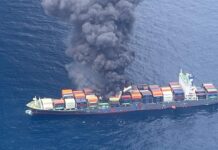
Maersk Line said today (17 July) that the Red Sea crisis has spread beyond its Asia-Europe network and has affected its whole worldwide portfolio.
CEO Vincent Clerc explained that the coming months will be challenging for carriers and businesses alike, as the Red Sea situation stretches into the third quarter of 2024.
Clerc was speaking at an online event with customers a week after the Danish carrier suffered another Houthi attack, when its US-flagged Maersk Sentosa escaped damage after being fired with missiles.
Clerc said that the rerouting of ships round the Cape of Good Hope is difficult for both carriers and shippers. Two to three additional ships are now needed on each service network. This has tightened tonnage supply, resulting in soaring charter rates.
Clerc noted, “Today, all ships that can sail and all ships that were previously not well utilised in other parts of the world have been redeployed to try to plug holes. It has alleviated part of the problem, but far from all the problems across the industry, including for Maersk. We are going to have in the coming month, missing positions or ships that are sailing that are significant different size from what we normally would have on that string, which will also imply reduced ability for us to carry all the demand that there is.”
Maersk’s statement said that Asian exports are more impacted than Asian imports by the ongoing situation in the Red Sea.
Maersk explained, “This is primarily because Asian countries are major global exporters, and China is the largest exporter to many Asian countries. Routes between the Far East and Europe via the Suez Canal have been directly impacted, with disruptions in the Red Sea affecting most trade routes. However, the disruptions have extended beyond Far East-Europe routes to the entire ocean network.
“Take the Oceania network, for example. Oceania’s ocean network is impacted by congestion in Southeast Asian hubs as these ports are crucial to connect Oceania’s cargo to Maersk’s global network. This is due to equipment shortages and constrained capacity from the Red Sea disruptions, which affects both alternative routes and transshipment hubs. The delays in Southeast Asian hubs pose a risk of disruption at Australian ports due to vessel bunching on arrival, resulting in longer waiting times and other delays.”
The congestion and disruption have extended beyond the hubs and into Northeast Asia and Greater China ports, causing delays. Maersk advised that Oceania exporters should factor in additional lead time as part of supply chain planning during this time.
Martina Li
Asia Correspondent








